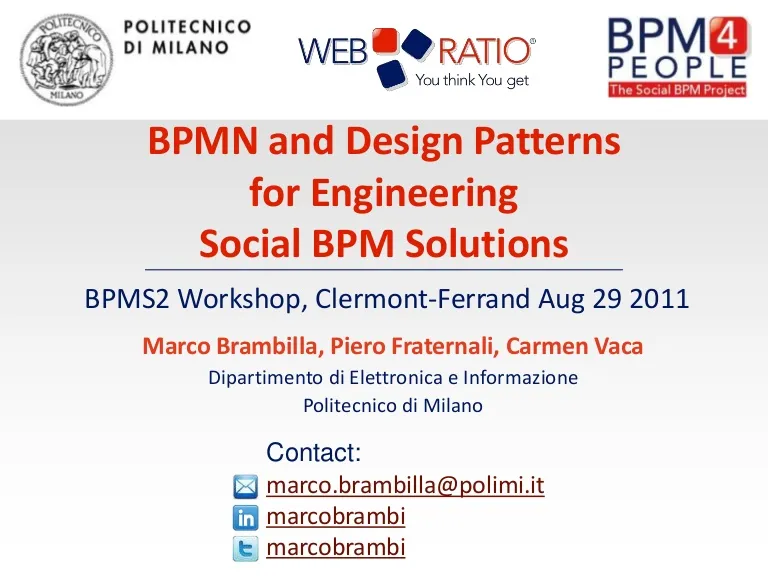BPMN and Design Patterns for Engineering Social BPM Solutions
Description
The integration of social software and BPM can help organizations harness the value of informal relationships and weak ties, without compromising the consolidated business practices embedded in conventional BPM solutions. This paper presents a process design methodology, supported by a tool suite, for addressing the extension of business processes with social features. The social process design exploits an extension of BPMN for capturing social requirements, a gallery of social BPM design patterns that represent reusable solutions to recurrent process socialization requirements, and a model-to-model and mode-to-code transformation technology that automatically produces a process enactment Web application connected with mainstream social platforms.
Transcript
BPMN and Design Patterns for Engineering
Social BPM Solutions
BPMS2 Workshop, Clermont-Ferrand Aug 29 2011
Marco Brambilla, PieroFraternali, Carmen Vaca
DipartimentodiElettronica e Informazione
Politecnico di Milano
Contact:
marco.brambilla@polimi.itmarcobrambimarcobrambi
Outline
- Understanding the goals of social BPMRepresenting social BP requirementsEliciting recurrent solutions: social design patternsAn exampleAn architecture for the fast prototyping and engineering of SBPM Conclusions: ongoing & future work (+ demo)
- EU Funded Project, 2 years4 SMEs + 2 UniversitiesCoordinator: Web Models (IT)Main deliverablesMethodologyModeling languagesReusable design pattersForward engineering architectureCases, cases, cases…
The Social BPM Space
A continuum from closed to open social BPM, where each organization can find the mix of control & flexibility it needs
Process model decided top-down and hard wired, task assignment rigid, communication limited to task input-output
ClosedBPM
Participatory design
Process model resulting from merge of different models (e.g., merger&acquisition), task/flow variants
Participatory enactment
Actors are fixed, but can communicate with social tools (e.g., follow up a task, tweet on a task status, etc)
The community of actors can be (in part) open: e.g.,
launch a task to be executed in Facebook, find an expert in LinkedIn, vote for alternative flows
Social enactment
Tasks are executed freely (e.g., in a Wiki-like mode)
process constraints are mined and progressively enforced by observing community behaviors
Process mining
The contribution of “social” to the BPM lifecycle
- Weak Ties / Tacit Knowledge exploitation (e.g., team formation) Knowledgesharing (e.g., self-service technical support)SocialFeedback (e.g., quality of service monitoring)Transparency: (e.g., legislation building)Participation: (e.g., participatory budgeting)Activitydistribution (e.g., crowd-sourced work)Decisiondistribution (e.g., social CRM)
Socialization
design
patterns
Socialization
goals
Modeltransformation
Participatory &
social enactment
Social BPM architecture
Overview of the approach
General idea:
Social BPM Design & Implementation
Analyze process improvement requirements
Understand SBPM goals
Identify communities of reference
Analysis & design
Understand process socialization patterns
Map requirements to goals
Identify relevant socialization patterns
Refer patterns to goals
(Re)design process with social interactions
Identify & abstract
social platforms to use
Automate pattern to application transformation
Map process model to
application models
Deployment
Refine
application models
Map application models
into code & deploy
Representing Social BPM requirements
Idea: extending BPMN with stereotypes for expressing:
- The participation of dynamically enrolled actors ( social pools with different roles)The execution of activities by such actors (social tasks)Events for controlling the execution of tasks by social actors
- As in the tradition of BPM design patterns, they capture reusable solutions to recurrent socialization requirements
Poll
Design patterns and goals
- Socialization goals can be used as drivers for the selection of the social BPM design patterns that are more relevant to a process socialization effort (SBPM by example)
Model Driven Engineering of SBPM applications
- Models are amenable to be transformed into running applications, enabling fast prototyping and early assessment of alternative process socialization strategies directly by the stakeholdersModel-Driven Engineeringis the discipline that supports a generative approach to the creation and maintenance of application from abstract, platform-independent modelsImplementation exploited WebRatio (www.webratio.com), an industrial MDE tool that manages app development in three steps:
Two types of models concur to define the application requirements:
Model extensions for Social BPM
Process and applications models are extended to incorporate social issues:
Pool
Vote
Follow
Lane 1
Lane 2
Generative approach and runtime architecture
Process layer
Presentation layer
Visual identity
Business layer
Servicelayer
Datalayer
Integrationlayer
Standard Java
Web application
Social Network connection services
IBMWebSphere
Caucho Resin
ApacheTomcat
OracleApplicationServer
JBoss
Application Server
Ongoing and future work
Ongoing work: reality check
- EU Parliament: IT requirement elicitation processes opened to all DGsNGO: consumers’ claim management and class action organizationPA: participative territory planningMultinational company: social CRM
- Complete the implementation of model editor, model transformation, social WebML componentsInvestigate SNA techniques for social task optimizationDefine social process improvement metrics and Social Activity Monitoring concepts
http://www.bpm4people.org/cms/content/en/demos
Contact:
Marco Brambilla
marco.brambilla@polimi.itmarcobrambimarcobrambi
